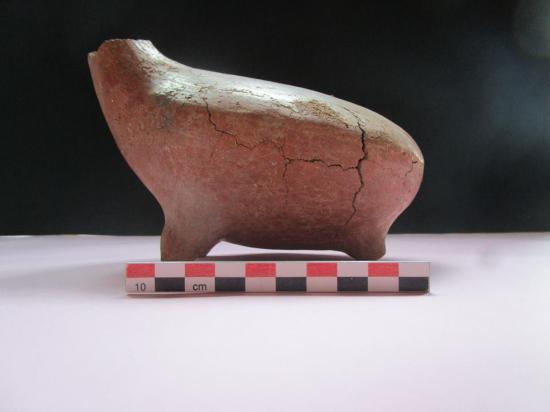Traces of grape pollen were found inside an animal-shaped ceramic jar used in ritual ceremonies
Mark Waghorn
Source - http://www.mirror.co.uk/news/world-news/traces-5000-year-old-grapes-8232961
Wine making began in the East European country of Georgia at least 5,000 years ago, suggests new research.
Traces of grape pollen from the world's first vineyard have been discovered inside an animal-shaped ceramic jar used in ritual ceremonies.
 It was dug up at an archaeological site called Aradetis Orgora - 62 miles (100 km) west of the Georgian capital Tbilisi.
It was dug up at an archaeological site called Aradetis Orgora - 62 miles (100 km) west of the Georgian capital Tbilisi.
The pottery dates to around 3,000BC and would have been used by an enigmatic village based people called the Kura-Araxes to ferment the fruit.
 The discovery adds further weight to Georgia's long-cherished and championed belief that it is the birthplace of wine making.
The discovery adds further weight to Georgia's long-cherished and championed belief that it is the birthplace of wine making.
The first evidence of domesticated grapes in the form of pips have also been unearthed in the south west of the country and date back 6,000 years.
It means Georgia really was the cradle of viticulture from where the technology spread to the so-called 'Fertile Crescent' of Mesopotamia and the Eastern Mediterranean.
The vessel has an animal-shaped body with three small feet and a pouring hole on the back. The head is missing.
It was found with a second similar vessel and a Kura-Araxes jar on the burnt floor of a large rectangular area with rounded corners - arguably a sort of shrine used for religious activities.
Scientists used a technique called radiometric (C14) analyses which dates specimens by determining proportions of chemicals to show they go back to 3000-2900 BC.
The vessel was examined at the Georgian Museum of Tblisi by palynologist Dr Eliso Kvavadze.
She found it contains numerous well-preserved grains of pollen of Vitis vinifera - a common grape vine that is still used to make wine today.
Dr Kvavadze said it shows wine's strategic role in the Kura-Araxes culture for ritual libations.
The ritual pourings would have been offered to a god or spirit or in memory of those who have died.
They were common in many religions of antiquity and continue to be offered in various cultures today.
Various substances have been used for libations - most commonly wine or olive oil, and in India, ghee.
The vessels used in the ritual often had a significant form which differentiated them from secular ones.
The libation could be poured onto something of religious significance, such as an altar, or into the earth.
The animals on both Georgian vessels could have represented gods and are a unique discovery in the region.
Professor Elena Rova, of the Ca' Foscari University of Venice, described it as a significant piece of history.
She said: "The context of discovery suggests wine was drawn from the jar and offered to the gods or commonly consumed by the participants to the ceremony."
The researchers said it's a key-finding for Georgia, where wine culture still continues in the course of traditional banquets called the Supra.
This is a spirited, lively and overwhelming feast where wine is consumed from vessels derived from animal horns in the context of elaborated ritual toasts.
The Kura-Araxes is the only prehistoric culture of the Southern Caucasus which spread over large areas of the Near East - reaching Iran and the Syro-Palestinian region.
Their pottery was distinctive and spread along trade routes into surrounding cultures. It was painted black and red using geometric designs. Examples have been found as far south as Syria and Israel, and as far north as Dagestan and Chechnya.
The people are also remarkable for the production of wheeled vehicles - wagons and carts - which were sometimes included in burials.